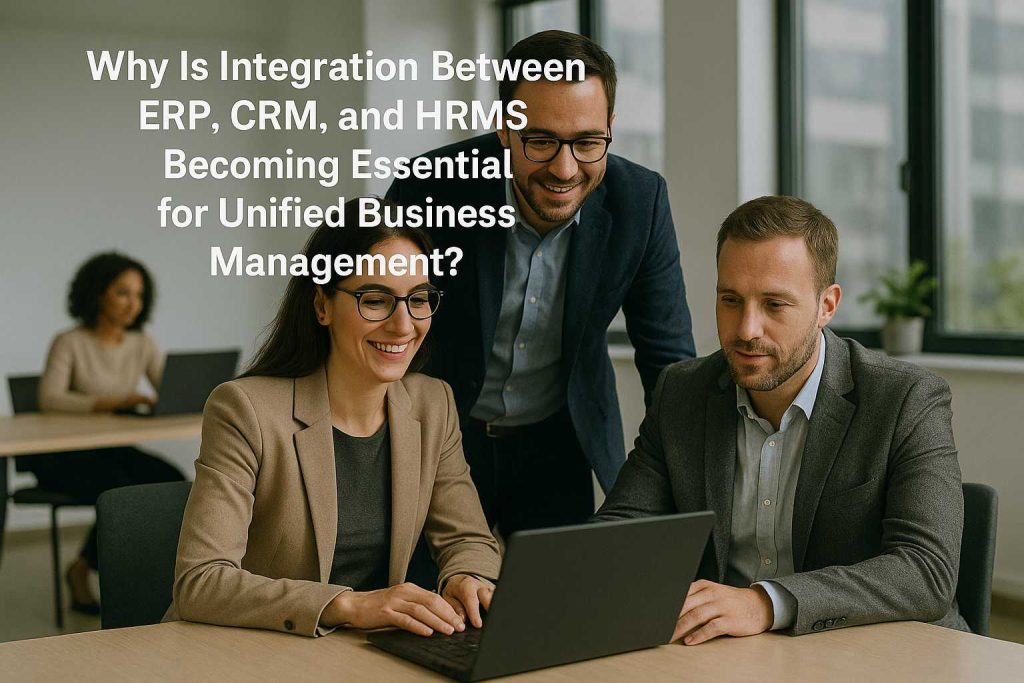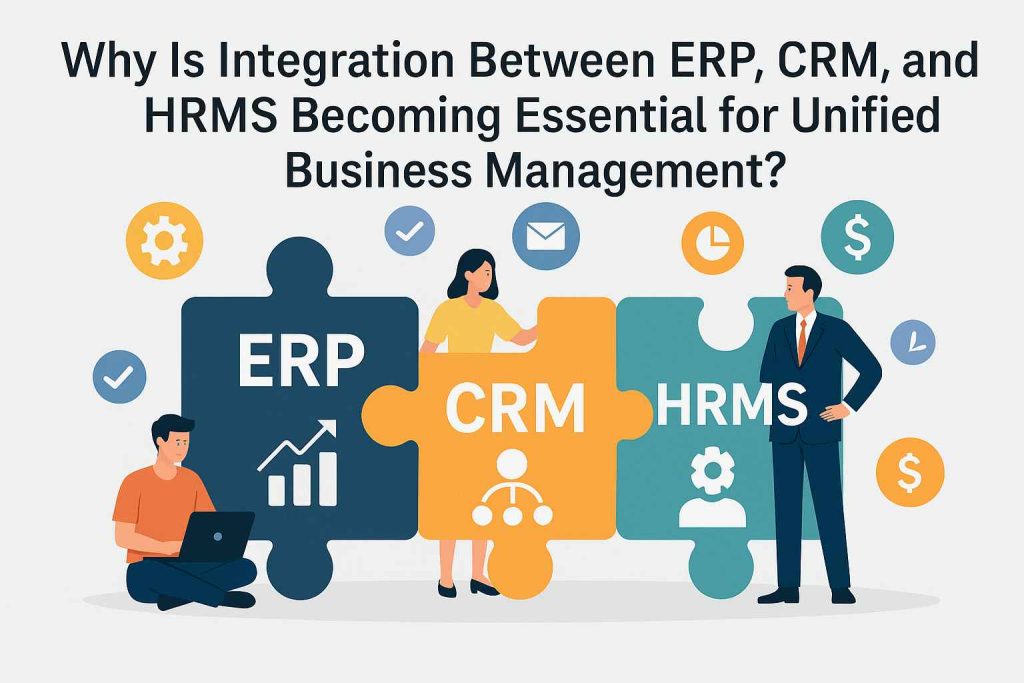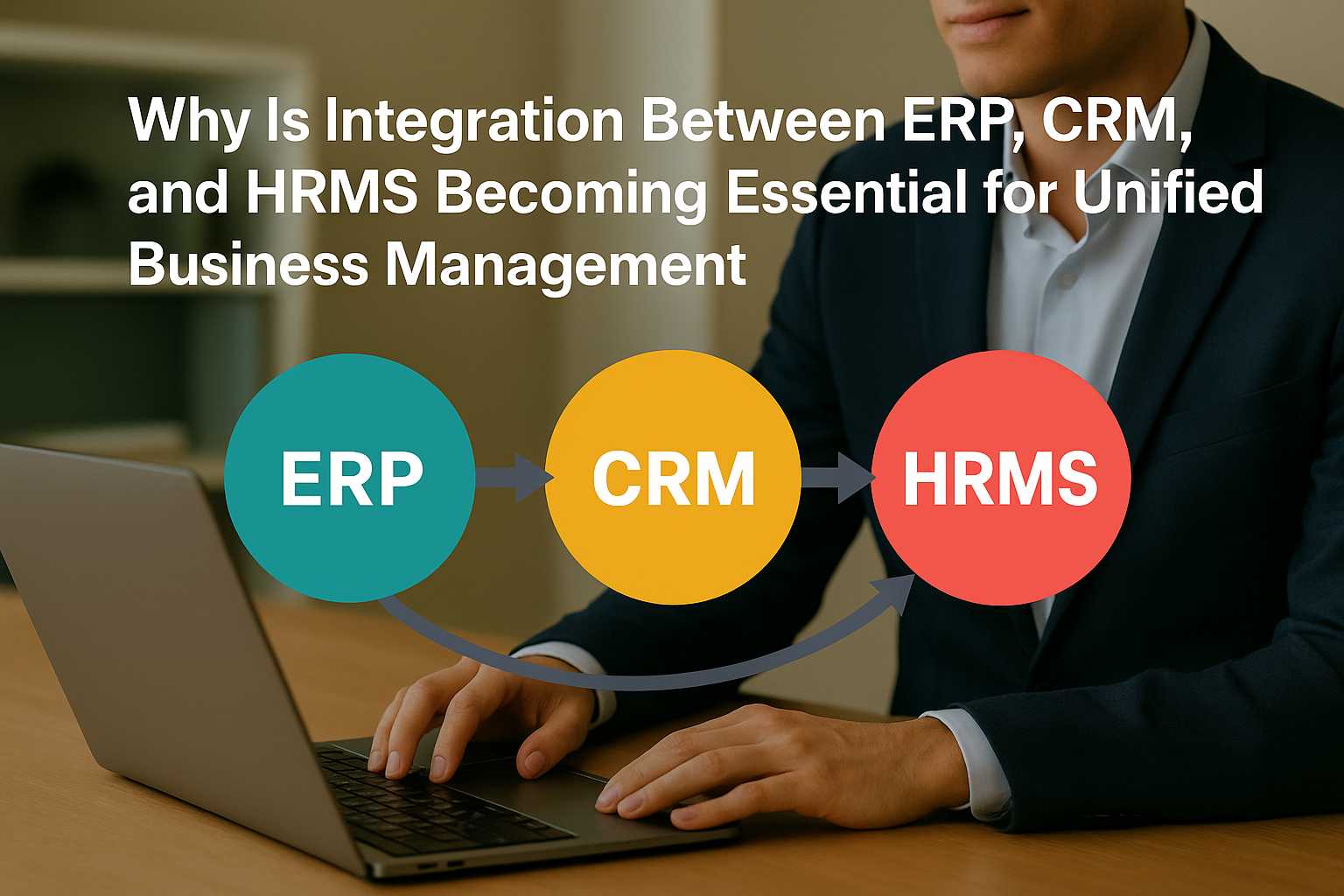In today’s fast-paced digital business environment, companies can no longer afford to run disconnected systems for managing their operations, customers, and workforce. The traditional approach—where ERP (Enterprise Resource Planning), CRM (Customer Relationship Management), and HRMS (Human Resource Management System) operate as separate entities—creates inefficiencies, data silos, and a lack of visibility across departments.
But modern enterprises are evolving. Businesses of all sizes—whether in manufacturing, retail, or service sectors—are realizing the immense potential of integrating ERP, CRM, and HRMS systems into a unified ecosystem. This integration is not just a technological advancement; it’s a strategic necessity for achieving real-time insights, seamless collaboration, and better decision-making.
Understanding the Core Systems: ERP, CRM, and HRMS
Before diving into the importance of integration, let’s briefly understand what each system does:
ERP (Enterprise Resource Planning)
ERP software acts as the backbone of an organization—handling everything from inventory management, procurement, production planning, accounting, and financial reporting to supply chain and distribution.
Solutions like WiderERP by Zymofar Dynamic Products Pvt. Ltd. provide a centralized platform that connects departments and optimizes business workflows across the organization.
CRM (Customer Relationship Management)
CRM focuses on managing relationships with customers and prospects. It helps businesses track leads, manage sales pipelines, improve customer service, and boost retention through personalized communication.
In retail and restaurant industries, tools like RetailMass and RestroPro integrate CRM features directly with billing and sales modules for smarter customer engagement.
HRMS (Human Resource Management System)
HRMS takes care of everything related to human resources—recruitment, payroll, attendance, leave management, performance tracking, and employee engagement.
An integrated HRMS not only simplifies administrative work but also enhances workforce efficiency and transparency.
The Problem with Disconnected Systems
Many businesses still run separate applications for ERP, CRM, and HRMS. While each performs its own function well, the lack of integration often leads to:
- Data Duplication: Information about customers, employees, or finances has to be entered multiple times in different systems.
- Operational Delays: Manual data sharing between departments causes inefficiencies and slow response times.
- Inconsistent Information: Different departments work with outdated or mismatched data, leading to poor decision-making.
- Limited Insights: Without cross-departmental visibility, businesses can’t analyze performance across operations, customers, and employees collectively.

The Power of Integration: A Unified Business Ecosystem
When ERP, CRM, and HRMS work together, businesses experience a level of synergy that transforms their operations. Let’s explore how integration drives real value:
Business Visibility
Integration ensures that all departments—sales, finance, HR, inventory, and production—are connected through a single platform. Managers can instantly access real-time reports showing revenue, workforce productivity, and customer trends.
For example, an integrated WiderERP system with CRM and HRMS can show how employee performance (from HRMS) influences customer satisfaction (CRM) and sales growth (ERP).
Smarter Decision-Making with Real-Time Data
When your ERP system pulls live data from HRMS and CRM, leadership teams can make informed decisions faster.
For instance:
- HR can analyze workforce productivity against sales performance.
- Management can forecast demand based on customer behavior.
- Finance teams can plan budgets with complete visibility into payroll, expenses, and sales revenue.
This data-driven culture leads to agility and faster strategic responses.
Enhanced Employee and Customer Experience
Integration improves both employee efficiency and customer satisfaction:
- Employees don’t need to switch between multiple software systems; they can view customer data, order history, and HR details in one interface.
- Customers receive faster service, accurate billing, and personalized attention because every department is working from a single source of truth.
Imagine a restaurant manager using RestroPro: sales data from the POS (ERP), customer feedback (CRM), and employee shift schedules (HRMS) all sync automatically—creating a seamless operational flow.
Improved Accuracy and Reduced Manual Work
Integration eliminates the need for redundant data entry. Whether you’re updating employee details, recording a customer payment, or tracking stock movement, all information flows automatically between systems.
This reduces human error, saves time, and ensures that the entire organization operates on consistent and accurate data.
Better Forecasting and Strategic Planning
With integrated analytics, leaders gain deep insights into how different areas of the business interact:
- Which employees drive the most customer retention?
- How do seasonal workforce patterns affect production or sales?
- How does customer demand impact inventory and cash flow?
By connecting the dots between HRMS (people), CRM (customers), and ERP (operations), businesses can make strategic plans backed by real-time evidence.
Scalability and Growth
As businesses expand, a unified platform allows easy scaling. Whether adding new branches, onboarding more employees, or introducing new product lines, integrated systems can adapt quickly without disrupting operations.
Zymofar’s WiderERP platform, for example, offers scalable modules that allow retail chains or restaurants to grow efficiently with synchronized CRM and HRMS capabilities.
Industry Impact: From Manufacturing to Retail and Restaurants
Integration is no longer a luxury—it’s a necessity across industries.
- 🏭 Manufacturing: ERP tracks production, CRM manages client orders, and HRMS aligns workforce shifts—ensuring production schedules match client demands.
- 🛍️ Retail: ERP manages inventory, CRM tracks customer loyalty, and HRMS ensures staffing efficiency during peak hours.
- 🍴 Restaurant: RestroPro integrates billing (ERP), customer data (CRM), and employee scheduling (HRMS) for smooth restaurant operations.
The Broader Business Advantage of ERP-Centric Integration
When ERP, CRM, and HRMS operate in harmony, the organization achieves true digital unification — every transaction, resource, and interaction becomes part of a single, intelligent ecosystem.
This integration goes beyond automation; it empowers enterprises to make faster, data-driven, and more strategic decisions.
While CRM focuses on customers and HRMS manages the workforce, the ERP system stands at the center, connecting both ends of the business — people and processes.
This synergy ensures that every business function — from production to payroll, from sales to service — flows seamlessly under one framework.
How ERP Integration Powers the Entire Business Cycle
- End-to-End Visibility
An integrated ERP system provides one centralized dashboard where leaders can monitor every aspect of business performance — sales, employee productivity, customer satisfaction, and cash flow — all in real time. - Reduced Data Silos
Without integration, data stays trapped in separate systems. Integration breaks these barriers — allowing instant communication between CRM (customers), ERP (operations), and HRMS (employees). - Operational Efficiency
Integrated ERP solutions automate cross-department workflows — such as auto-updating HR data when payroll is processed or synchronizing customer sales data directly from CRM into ERP accounts. - Smarter Resource Allocation
Businesses can analyze workforce capacity (HRMS) against production demand (ERP) and customer requirements (CRM), ensuring balanced utilization of people and processes. - Real-Time Decision Support
With synchronized data, management can act immediately on changes in demand, staffing needs, or production levels — avoiding downtime and lost revenue.
Cross-Functional ERP Integration Benefits
| Business Area | Traditional System (Disconnected) | Integrated ERP–CRM–HRMS System | Business Outcome |
|---|---|---|---|
| Production Planning | Manual updates, isolated data | Real-time coordination between demand (CRM) and resource availability (HRMS) | On-time and cost-efficient production |
| Sales & Billing | Separate CRM and billing systems | CRM data automatically syncs with ERP billing and accounts | Faster invoicing and reduced data entry errors |
| Human Resources | Independent HR software | HRMS data flows into ERP for payroll, shift planning, and expense management | Accurate payroll and resource forecasting |
| Customer Support | Disconnected service logs | ERP service module linked to CRM for complete service history | Improved response time and customer satisfaction |
| Financial Reporting | Time-consuming reconciliation | Centralized data across ERP, CRM, and HRMS | Accurate and instant financial visibility |
Measurable Impact of ERP Integration
| Key Metric | Before Integration | After ERP–CRM–HRMS Integration | Improvement (%) |
|---|---|---|---|
| Data Accuracy | 70% (due to manual entry errors) | 98% (due to synchronized systems) | +40% |
| Operational Efficiency | Moderate (disconnected workflows) | High (automated, cross-linked modules) | +55% |
| Decision-Making Speed | Slow (delayed data updates) | Real-time dashboards and analytics | +65% |
| Employee Productivity | Average (multiple systems to update) | Optimized (single unified platform) | +50% |
| Customer Satisfaction | Inconsistent (fragmented service data) | Consistent (complete customer view) | +35% |

Why Integration Is the Future of ERP Software
In 2025 and beyond, ERP software will no longer work in isolation. The future lies in intelligent integration — connecting ERP with HRMS and CRM to form a unified digital core.
Such connected systems enable:
- Predictive analytics for sales and workforce planning.
- Automated financial reconciliation from HR and customer data.
- Seamless communication between departments and locations.
- Centralized dashboards for real-time insight and forecasting.
Modern ERP platforms like WiderERP by Zymofar Dynamic Products Pvt. Ltd. are designed exactly for this purpose — to unify every business function under one powerful, data-driven ecosystem.
The Zymofar Advantage
At Zymofar Dynamic Products Pvt. Ltd., our ERP solutions go beyond standard automation.
We focus on integration, intelligence, and industry adaptability — ensuring businesses across manufacturing, retail, distribution, and hospitality can streamline operations effortlessly.
With WiderERP, companies can:
✅ Integrate CRM and HRMS modules in real-time
✅ Monitor financials, production, and workforce performance in one view
✅ Automate billing, payroll, and reporting
✅ Access cloud-based dashboards from anywhere
✅ Achieve faster ROI with improved productivity and customer satisfaction
Integration Is Not Optional — It’s Strategic
In the age of digital business transformation, ERP–CRM–HRMS integration is the foundation of unified management.
Businesses that still run isolated systems face inefficiency, duplication, and data errors — while those embracing integration gain speed, accuracy, and control.
ERP sits at the center of this digital ecosystem — driving collaboration between people, processes, and customers.
The future belongs to businesses that harness this synergy to deliver smarter operations, higher profitability, and sustained growth.
🌐 Zymofar Dynamic Products Pvt. Ltd.
Innovating Smarter ERP Software for a Connected Future
📍 Bangalore, India
📞 +91 7090335533
🌐 www.zymofar.com


